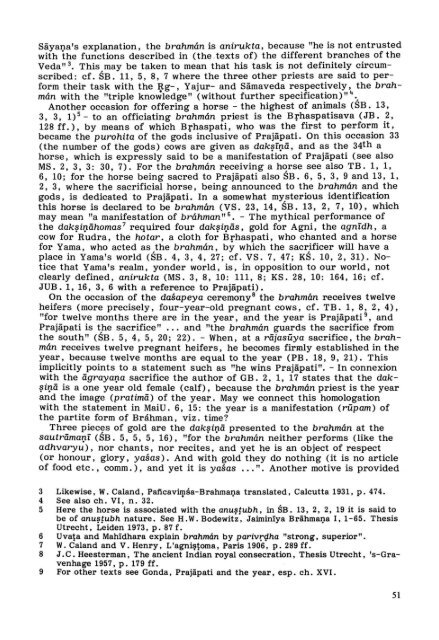Prajapati's relations with Brahman, Brhaspati and Brahma - DWC
Prajapati's relations with Brahman, Brhaspati and Brahma - DWC
Prajapati's relations with Brahman, Brhaspati and Brahma - DWC
You also want an ePaper? Increase the reach of your titles
YUMPU automatically turns print PDFs into web optimized ePapers that Google loves.
Säya~a's explanation, the brahmán is anirukta, because "he is not entrusted<br />
<strong>with</strong> the functions described in (the . texts of) the different branches of the<br />
Veda" 3. This may be taken to mean that his task is not definitely circumscribed:<br />
cf. SB. 11, 5, 8, 7 where the three other priests are said to perform<br />
their task <strong>with</strong> the Rg-, Yajur- <strong>and</strong> Sämaveda respectively, the brahmán<br />
<strong>with</strong> the "triple knowiedge" (<strong>with</strong>out further specification)" 4 "<br />
Another occasion for offering a horse - the highest of animals (SB. 13,<br />
3, 3, 1)5 - to an officiating brahmán priest is the <strong>Brhaspati</strong>sava (JB. 2,<br />
128 ff.), by means of which <strong>Brhaspati</strong>, who was the first to perform it,<br />
became the purohita of the gods inclusive of Prajäpati. On this occasion 33<br />
(the number of the gods) cows are given as dak{>f~ä, <strong>and</strong> as the 34t h a<br />
horse, which is expressly said to be a manifestation of Prajäpati (see also<br />
MS. 2, 3, 3: 30,7). For the brahmán receiving a horse see also TB. I, I,<br />
6, 10; for the horse being sacred to Prajäpati also SB. 6, 5, 3, 9 <strong>and</strong> 13, I,<br />
2, 3, where the sacrificial horse, being announced to the brahmán <strong>and</strong> the<br />
gods, is dedicated to Prajäpati. In a somewhat mysterious identification<br />
this horse is declared to be brahmán (VS. 23, 14, SB. 13, 2, 7, 10), which<br />
may mean "a manifestation of hráhman" 6. - The mythical performance of<br />
the dak{>i~ähomas7 required four dak{>i~äs, gold for Agni, the agnfdh, a<br />
cow for Rudra, the hotar, a cloth for <strong>Brhaspati</strong>, who chanted <strong>and</strong> a horse<br />
for Yama, who acted as the brahmán, by which the sacrificer will have a<br />
place in Yama's world (SB. 4, 3, 4, 27; cf. VS. 7, 47; KS. 10, 2, 31). Notice<br />
that Yama's realm, yonder world, is, in opposition to our world, not<br />
clearly defined, anirukta (MS. 3, 8, 10: 111, 8; KS. 28, 10: 164, 16; cf.<br />
JUB. I, 16, 3, 6 <strong>with</strong> a reference to Prajäpati).<br />
On the occasion of the dasapeya ceremony8 the brahmán receives twelve<br />
heifers (more precisely, four-year-old pregnant cows, cf. TB. 1,8,2,4),<br />
"for twelve months there are in the year, <strong>and</strong> the year is Prajäpati 9, <strong>and</strong><br />
Prajäpati is the sacrifice" ... <strong>and</strong> "the brahmán guards the sacrifice from<br />
the south" (SB. 5, 4, 5, 20; 22). - When, at a räjasüya sacrifice, the brahmán<br />
receives twelve pregnant heifers, he becomes firmly established in the<br />
year, because twelve months are equal to the year (PB. 18, 9, 21). This<br />
implicitly points to a statement such as "he wins Prajäpati". - In connexion<br />
<strong>with</strong> the ägraya~a sacrifice the author of GB. 2, I, 17 statés that the dak<br />
{>i~ä is a one year old female (calf), because the brahmán priest is the year<br />
<strong>and</strong> the image (pratimä) of the year. May we connect this homologation<br />
<strong>with</strong> the statement in MaiU. 6, 15: the year is a manifestation (rüpam) of<br />
the partite form of Bráhman, viz. time?<br />
Three piec~s of gold are the dak{>i~ä presented to the brahmán at the<br />
sauträma~f (SB. 5, 5, 5, 16), "for the brahmán neither performs (like the<br />
adhvaryu), nor chants, nor recites, <strong>and</strong> yet he is an object of respect<br />
(or honour, glory, yasas). And <strong>with</strong> gold they do nothing (it is no article<br />
of food etc., comm.), <strong>and</strong> yet it is yasas ... ". Another motive is provided<br />
3 Likewise, W. Cal<strong>and</strong>, Pancavllpsa-<strong>Brahma</strong>l}a translated, Calcutta 1931, p. 474.<br />
4 See also ch. VI, n. 32.<br />
5 Here the horse is associated <strong>with</strong> the anustubh, in SB. 13, 2, 2, 19 it is said to<br />
be of anu~tubh nature. See H.W. Bodewit~', Jaiminïya Brähmal}a I, 1-65. Thesis<br />
Utrecht, Leiden 1973, p. 87 f.<br />
6 Uvata <strong>and</strong> Mahïdhara explain brahmán by parivr{1ha "strong, superior".<br />
7 W. Cal<strong>and</strong> <strong>and</strong> V. Henry, L'agni~toma, Paris 1906, p. 289 ff.<br />
8 J. C . Heesterman , The ancient Indian royal consecration , Thesis Utrecht, 's-Gravenhage<br />
1957, p. 179 ff.<br />
9 For other texts see Gonda, Prajäpati <strong>and</strong> the year, esp. ch. XVI.<br />
51
















